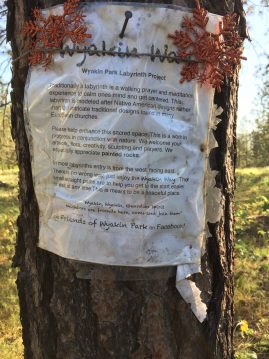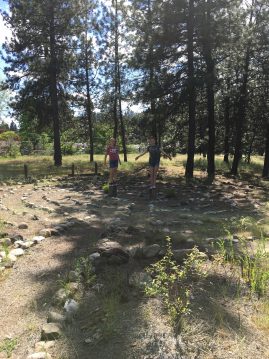By Heidi Scott
If you are looking for something new to try this summer with your friends and family, you might consider becoming a labyrinth walker. Mysterious as it is intriguing, labyrinth walking seems to be one of the lesser known, but universal practices of humanity.
Sacred labyrinths and labyrinth walkers have existed for thousands of years. There is evidence that people as far back as Neolithic times used sacred labyrinths for ritual dance ceremonies. Ancient labyrinth remains have been found across the world in places such as Sweden, Russia, India, Brazil, and Arizona. Today, people still dance in them for rituals in some countries, including Greece, Bulgaria, and Malaysia.
Scholars believe that in the beginning, they were used mostly at funerals, celebrations, and other rituals. Through time, cultures adapted them according to their own needs. In equine-focused communities, they were even built for horses.
According to the Labyrinth Society, labyrinths in Europe were taken from the mystical realm around 2,500 B.C., and seen exclusively as a spiritual tool. Christianity began adopting them as early as the 4th Century, with increased popularity up to the 12th Century. The most famous labyrinth in the world is the 42-foot Chartres Cathedral labyrinth in France. These early religious labyrinths represented the path of a soul through life, and at times, pilgrims would follow them on their knees, seeking to be closer to God.
Today we can find labyrinths in schools, prisons, healthcare centers, and retreat settings. They continue to provide a way to connect to a spiritual center, and to our own humanity.

Different from mazes, labyrinths do not have intersections or branches, making it impossible to get lost. They are simple, winding paths imprinted, painted, or built into a surface. These paths lead walkers on a journey from start to finish without the need to make any decisions. Once in the middle, a walker merely has to turn around and follow the same path back out.
Some are large, taking up acres of land, but typically they are fairly humble in size. Construction materials vary from the finest tile to beaten earth. Even small, pictorial labyrinths designed to be traced with the eye are meditative. These symbolic labyrinths take many forms as well, paintings, mosaics, and even coins. No matter the form, though, the intent is always the same. It quiets the mind.
“It temporarily disturbs the rational conscious orientation to the point that the initiate is ‘confused’ and symbolically ‘loses his way.’ Yet in this descent into chaos the inner mind is opened to…awareness.”[1]
When walking a labyrinth, there are a few stages that a newcomer might experience. In the beginning, it might seem just like childish fun, with an anticipation of what is to come. After the first few turns, a feeling silliness and self-consciousness often arises. The walker might look around, hoping nobody is watching. To the rational mind, walking in circles in the middle of a forest, building, or garden is difficult to justify.
Some people stop following the path at this point, and simply walk across the lines to reach the center. They deprive themselves from the full experience, so new walkers are encouraged to set aside any uncomfortable sensations for a moment, and allow the next phase to happen.
After the silliness passes, a walker will often notice their senses being heightened. They notice things about the path and their environment that they didn’t notice before. The giddiness turns into awareness, and the mind gets quieter. Concerns begin to drift in and out of the mind, and the walker’s mind moves into the present. Because you have to keep your eye on the path, the feeling of self-consciousness fades quickly. By the end, walkers often has a sense of satisfaction and success.
A refreshing chance to examine ourselves, labyrinths offer an opportunity to exercise mindfulness. People report feeling energized and more mentally alert after completing labyrinths. Many are smiling and even laughing by the end. When completed with others, a bond takes place that is often a lovely experience.
Some people seek out labyrinths as a chance to spiritually center, using them as a meditative tool. They focus on letting go of everyday cares as they walk. When they reach the center, they pray, ponder, or reflect before retracing their steps to the beginning. This last step is important. To get the full experience, walkers should follow the path back to the entrance. When used purposefully and often, labyrinth walking can be a transformative tool. A chance to remove one’s self from the world. Another word of advice to new labyrinth walkers: Leave your phone in the car. Allow yourself the space to feel present in the moment, for that is the purpose of this experience.
At least nine labyrinths exist near Spokane. Some are in fairly rough shape, such as the one behind the Episcopal Cathedral of St. John the Evangelist at 127 East 12th. This was built from earth and stones by the church’s youth group many years ago, and has become so overgrown that it is difficult to find the way at times. But the rustic experience is still invigorating. You might want to ask someone from the church to show you where it is, because it is not marked. While you’re in the church, you can also check out their painted canvas labyrinth.

A larger labyrinth at Wyakin Park is also a little tricky to follow, and welcomes the community to help maintain it with painted rocks. It is located in a wooded nature area at 6701 N Assembly St.

Other labyrinths are far more formal and well-kept. The brick and paver labyrinth behind the Our Lady of the Lake Catholic Church at 6122 Highway 291, in Nine Mile Falls has markers and parking designated for visitors.

Spokane Community College’s Horticulture Club and Landscape Installation Class built a labyrinth on campus out of bricks and pavers. It is on the north side of E. Ermina Avenue, near building 8. Similar to the Our Lady labyrinth, this one is easy to find and well maintained. The Spokane River flows nearby, adding to the peaceful experience.

The labyrinth at Country Homes Christian Church, 8415 North Wall Street, also has a sense of the sacred. It has items in the center that indicate religious worship left over from previous walkers. Even though it is located at a busy intersection, it provides a quiet place to take a moment away from the business and chaos of the everyday.

The community garden behind the West Central Episcopal Mission, at 1832 W. Dean Avenue, has a labyrinth that clearly links to the spiritual aspect. In its center lies a great cross, prompting walkers to think of their soul as they walk toward it.

The simplest way to find a labyrinth near you is to go to labryinthlocator.com, a world-wide database that attempts to keep track of labyrinths in every continent, both ancient and modern. While it is impossible to keep a comprehensive list of every labyrinth in the world, The Labyrinth Society does a great job of getting people started. Their website offers a great deal of information about the history and use of labyrinths, as well as a way to connect with others who are interested in walking, designing, and building them.
[1] Henderson, Joseph L., and Maud Oakes. The wisdom of the serpent: the myths of death, rebirth, and resurrection. Princeton, NJ: Princeton U Press, 1990.









Honestly… all the mumbo jumbo about spiritual and centered could’ve been left out.
Its a fun and relaxing experience would’ve conveyed the same without such new age nonsense on top of it.